Posted by Michael Haran on May 21, 2014
The official kickoff of the 4th District supervisorial race may have been on April 28th at Cardinal Newman High but the real start was on April 23rd at the Windsor Grange Hall when the five candidates met to say what they would do about Sonoma County’s poor roads if they were elected to replace outgoing Mike McGuire who is running for the state senate.

Mike McGuire
Sponsored by SOS Roads, a local road improvement advocacy group, the topic drew a group of about forty people. Bill Finkelstein and Craig Harrison of SOSR were moderators and Mike McGuire was the master of ceremonies. Having McGuire at the meeting was tailor made for the candidates to take pot shots at what the county has done on road maintenance and other things.
Mike opened the discussion by PowerPoint highlighting what the county has done toward road since he became supervisor in 2010. He said, “This is a legacy problem,” as past supervisors withheld money for road repairs. The county has spent over $8 million from the general fund in the past two years to repair 40 miles of priority roads. He showed slides of new roads on Westside, W. Dry Creek; Eastside; Lytton Springs; and Geyserville Roads. He said a top priority is to put sidewalks in Geyserville. McGuire continued that the county is working on finding more money for more road repair. He then turned the program over to Director of Transportation and Public Works Susan Klassen.
Susan showed slides of how the spending on roads had decreased over the past thirty years. One slide really stood out. It was a vertical bar graph that showed how much money each California County received from gas tax. Because state road maintained allotments are based on population, Orange County, with a population of over three million and 312 miles of paved roads compared to Sonoma County’s population of just under five hundred thousand and 1,370 miles of paved roads, gets about six times what Sonoma gets(Orange County must have really nice roads).
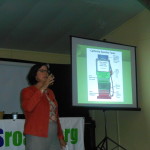
Susan Klassen
When asked what they would do to improve county road conditions the candidates took turns. Pete Foppiano wants to see a change in the way gas tax is distributed stating that the current formula favors counties with high a number of registered vehicles and small road networks. James Gore targeted unfunded pension liability in wanting to reform the county budget but didn’t support new taxes. “I won’t kick the can down the road, because it will probably fall into a pothole,” he said.
Keith Rhinehart said that the idea of spending millions of dollars on cycling routes that affect 1 percent of the commuting public is unconscionable and that he would eliminate bike path construction in favor of road repairs and tax cyclists. Finkelstein reminded Rhinehart that cyclists also drive cars and so pay the same taxes as everyone else. Rhinehart said that he will work as hard as anyone to fix this pension crisis.
Deb Fudge said she is wants to hear the county’s long-term roads plan, which McGuire said would be released within 60 days, and is interested in the $1 billion plus, 20-year project to rehabilitating the entire road network. When she said that it could be paid for by a sales or property tax increase one women in the audience commented, “No way.” Fudge quickly added, “Only with voter approval.” I don’t think Fudge is getting that women’s vote.
Ken Churchill, a longtime advocate of overhauling pensions, said that pensions are costing us money that is not fixing our roads and new taxes are not going to do it. When McGuire said that the county’s pension liability is now about 80% funded, Churchill challenged that figure saying that it’s closer to 60%. McGuire then said that the new actuarial figures backed him up and Churchill admitted that he hadn’t seen the new figures. McGuire went on to counsel the pension hawks saying that even with futures savings it’s not a dollar for dollar deal.

SOS Roads Forum
As the debate/conversation continued to intensify McGuire, as only he would do, decided that everyone needed chocolate so he passed around a basket. Finkelstein spotted Jim Wood, Healdsburg mayor and candidate for the 2nd Assembly district, and ask if he anything to add to the road conversation. Wood said that he didn’t as he was there on a fact finding mission.
Craig Harrison held up a sign that said “Tired of Potholes?” go to SOSRoad.org.” He said anyone who wants a sign should go to the organization’s website which is an excellent resource for information regarding Sonoma County roads. He continued that a statewide pension fix would help improve all nine Bay Area roads. To that end they have filed a “Friend of the Court” brief in the City of Stockton federal bankruptcy case arguing that retirement benefits owed to city workers should not emerge unscathed from a municipal bankruptcy.
All and all it was a fun get-together. The crowd was engaged and even a local climate denier, who kept blurting out “junk science” (about what wasn’t clear), didn’t dull the interchange. Local politics at its best.
Read More
Posted by Michael Haran on May 9, 2014
A few weeks ago I attended the Piner Highs School open house for their new high tech science building. The $3.6 million dollar structure (the full size planetarium is awesome), officially known as the Science Position Astronomy Research Quest Center, or SPARQ, was built to house the schools STEM (science, technology, engineering and Math) classes. To see the new facility go to: http://sparqatphs.com/index.html
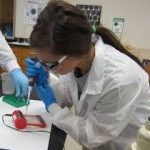
Testing for GMO
I came upon a group of fifteen-year old students at the Health Science and Biotechnology table who were eager to show me how to test a food sample to see if it had been genetically modified. They showed me the micropipette in which the mashed food sample is placed along with a gel solution to separate the DNA from the rest of the cellular components. Simply stated, the DNA then needs to be copied many times because more DNA than is found in the food is needed for testing. This is done through a procedure known as Polymerase Chain Reaction or PCR in which the food DNA is unwound. The last step is to visualize the DNA and see if the DNA has been modified. This is usually done by gel electrophoresis. These students are a lot smarter than I was at fifteen – than I am now for that matter.
To really get into how to test for GMOs go to: http://www.hudsonalpha.org
At lot about GMOs (Genetically Modified Organisms) has been in the news lately and you know the subject is gaining main stream consciousness when a high school STEM course is teaching how to test for the presence of GMOs in their food.

California Prop 32 Campaign Poster
A California initiative, Prop 37, which would have required GMO labeling of all food by retailers and food companies, was defeated last November and California State Senator Noreen Evans is trying to get the job done through the California legislature by introducing a bill requiring all consumer food must contain GMO labeling. In Vermont they just passed legislation (5/8/2014) making the state the first to require food producers to label products made with generic engineering. The law won’t go into effect for two years and producer lawsuits are expected. Vermont Gov. signs GMO Labeling into Law http://radioboston.wbur.org/2014/05/08/vermont-gmo-labeling.
All GMOs are not bad. The GMO process in nature is known as evolution although nature’s process takes considerably longer (thousands and even millions of years) than the man-made kind. Technically GMOs are experimental plants or animals that have been genetically engineered in a laboratory with DNA from other plants, animals, bacteria or virus.
the man-made kind. Technically GMOs are experimental plants or animals that have been genetically engineered in a laboratory with DNA from other plants, animals, bacteria or virus.
There are two main reasons for GMOs. First, seed producers modify their seeds to make them resistant to their brands of herbicides; and second, seed producers modify plants to contain built-in pesticides. Today, GMO ingredients are found in 80% of the packaged foods in the U.S. GMO crops are also added to processed foods as oils and sweeteners.
To make a GMO, three main components are required: the gene you want to transfer, the organism you want to put it into (target species), and a vector to carry the gene into  the target species cells. The steps are relatively straightforward, but can be technically challenging. The gene to be transferred (trans-gene) must be cut out and isolated from the original organism. This is usually done by restriction enzymes, which are like molecular scissors that recognize specific sequences in the DNA and cut it at those places.
the target species cells. The steps are relatively straightforward, but can be technically challenging. The gene to be transferred (trans-gene) must be cut out and isolated from the original organism. This is usually done by restriction enzymes, which are like molecular scissors that recognize specific sequences in the DNA and cut it at those places.
To really get into how to make a GMO go to: http://www.hudsonalpha.org
For some, the idea of GMO food is a good because the modifications allow crops to become resistant to drought and infestations, letting more people have more regular meals. Some research even shows that the world produces 17% more food than it needs to produce to provide each current human with three meals per day.

Rats with tumors
Others look at genetically modified foods as dangerous. From allergic reactions to potential intestinal damage, many people wish to avoid GMO foods because of animal studies that have shown changes in internal cell structure, abnormal tumor growth, and unexpected deaths that have occurred.
Another reason people distrust GMO foods is that they are so new to our food chain. People feel that they are the “lab rat” generation for the big Ag companies to see what happens to humans after a generation of eating GMO foods.
If you want to know more about this go to: http://organicconnectmag.com
When it comes to the mass the mass production of GMO foods the benefits need to outweigh the risks. In some areas, having access to GMO foods may make sense because resources are thin and people are dying from hunger. However, in other areas the risks may outweigh the rewards. So what exactly are the pros and cons of genetically modified foods?
Pros of Genetically Modified Foods:

GMO vegetables
1. Better overall quality and taste
Through the modification of foods, the flavors can be enhanced. Peppers can become spicier or sweeter. Corn can become sweeter. Difficult flavors can become more palatable.
2. More resistant to disease

Corn without GMO
Plants and animals that have been genetically modified can become more resistant to the unexpected problems of disease. Think of it as a vaccine for that plant or animal, except that the vaccine is encoded into the genetics instead of a shot given to the immune system.
3. More nutrition benefits
GMO foods can have vitamins and minerals added to them through genetic modifications to provide greater nutritive benefits to those who eat them. This is especially common in developing countries that don’t always have the access to needed resources.
common in developing countries that don’t always have the access to needed resources.
Cons of Genetically Modified Foods
Here are the primary problems with GMO foods:
1. Environmental damage
By growing plants or raising livestock in environmental conditions that normally wouldn’t support them, there is the potential of irrevocably damaging that environment. This is often seen through GMO crossbreeding – weeds, for example, that can be crossed with GMO plants can often become resistant to herbicides, creating the need for more GMO efforts.
2. There is no economic value
GMO foods take just as long to mature and take just as much effort to grow, meaning that there is no real economic value to growing GMO foods when compared to non-GMO foods. In addition, growers have seen little economic gain from the use of GMO crops.
3. A growth in allergic reactions in the general population
 Time and time again, studies have shown that the consumption of GMO foods increases the risks of food-based allergies in people. If someone develops an allergy to soy because of GMO efforts, then if livestock eats that GMO soy as well, that person would have a high probability of an allergic reaction from eating the animal meat. Do the benefits outweigh the risks?
Time and time again, studies have shown that the consumption of GMO foods increases the risks of food-based allergies in people. If someone develops an allergy to soy because of GMO efforts, then if livestock eats that GMO soy as well, that person would have a high probability of an allergic reaction from eating the animal meat. Do the benefits outweigh the risks?
The following is brief timeline of the development of GMO:

In 1935, a Russian scientist, Andrei Nikolaevitch Belozersky, isolates pure DNA.
In 1953, James Watson and Francis Crick publish their discovery of the three-dimensional double helix structure of DNA. This discovery will eventually lead to the ability of scientists to identify and “splice” genes from one kind of organism into the DNA of another.
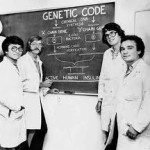
In 1973, the idea for man-made DNA, or Recombinant DNA (rDNA), comes from a grad student at Stanford University Medical School. Professor Herbert Boyer and a few of his biologist colleagues develop it.
In 1975, a group of biologists get together (the Asilomar Conference) with a few lawyers and doctors to create guidelines for the safe use of genetically engineered DNA. 
In 1980, the U.S. Supreme Court rules (5-4) that genetically altered life forms can be patented. The decision allowed the Exxon Oil Company to patent an oil-eating microorganism.
In 1982, the U.S. Food and Drug Administration approved the first genetically engineered drug, Genentech’s Humulin, a form of human insulin produced by E. coli bacteria. This becomes the first consumer product developed through modern bioengineering.

In 1987, the first field tests of genetically engineered crops (tobacco and tomato) were conducted in the United States.
In 1992, the FDA declared that genetically engineered foods are “not inherently dangerous” and do not require special regulation.
In 1994, FDA approves the “Flavr Savr” tomato for sale on grocery store shelves. The delayed-ripening tomato has a longer shelf life than conventional tomatoes.
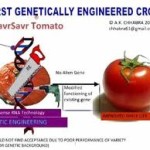
FlavrSavr Tomato
In 1996, weeds resistant to glyphosate, the herbicide used with many GMO crops, are detected in Australia. Research shows that the super weeds are seven to 11 times more resistant to glyphosate than the standard susceptible population.
In 1997, the European Union rules in favor of mandatory labeling on all GMO food products, including animal feed.
 In 1999, Dr. Zhiyuan Gong, at the National University of Singapore, injected a green fluorescent jellyfish gene into a zebra fish embryo, allowing it to integrate into the fish’s genome. The goal was to develop a fish that could detect pollution by selectively fluorescing in the presence of environmental toxins. The fish are now sold worldwide as Glofish.
In 1999, Dr. Zhiyuan Gong, at the National University of Singapore, injected a green fluorescent jellyfish gene into a zebra fish embryo, allowing it to integrate into the fish’s genome. The goal was to develop a fish that could detect pollution by selectively fluorescing in the presence of environmental toxins. The fish are now sold worldwide as Glofish.
In 1999, over 100 million acres worldwide are planted with genetically engineered seeds. The marketplace begins embracing GMO technology.
In 2000,International Biosafety Protocol is approved by 130 countries at the Convention on Biological Diversity in Montréal, Canada. The protocol agrees upon labeling of genetically engineered crops, but still needs to be ratified by 50 nations before it goes into effect.
 In 2003, a Bt-toxin-resistant caterpillar-cum-moth, Helicoverpa zea, is found feasting on GMO Bt cotton crops in the southern United States. In less than a decade, the bugs have adapted to the genetically engineered toxin produced by the modified plants.
In 2003, a Bt-toxin-resistant caterpillar-cum-moth, Helicoverpa zea, is found feasting on GMO Bt cotton crops in the southern United States. In less than a decade, the bugs have adapted to the genetically engineered toxin produced by the modified plants.
In 2011, research in eastern Quebec finds Bt toxins in the blood of pregnant women and shows evidence that the toxin is passed to fetuses.

In 2012, French farmer Paul Francois sues Monsanto for chemical poisoning he claims was caused by its pesticide Lasso, part of the Roundup Ready line of products. Francois wins and sets a new precedent for future cases.
In 2014, Monsanto’s patent on the Roundup Ready line of genetically engineered seeds will end in two years. In 2009, Monsanto introduced Roundup 2 with a new patent set to make the first-generation seed obsolete.
Read More
Posted by Michael Haran on Feb 26, 2014
COMMENTARY
Since I have recently been dragged into the climate debate I decided to do some of my own research on the subject. I came across this amazing website called www.scepticalscience.com. The site lists climate 172 “denier” statements like “climate’s changed before;” “It’s the sun;” and “Climategate CRU emails suggest conspiracy.” The neat thing about the site is that each “denier” comment has a rebuttal that links to the source of that rebuttal.
I clicked on “There’s no correlation between CO2 and temperature” and here’s some of the info that came up:
Water vapor constitutes about 95% of the earth’s greenhouse gases, 3% is CO2 and 2% is methane. The question is what percentage of that 3% is man-made and is that man-made portion really effecting climate change or is there a natural cycle at play here?
The amount of CO2 is increasing all the time – we just passed a landmark 400 parts per million concentration of atmospheric CO2, up from around 280ppm before the industrial revolution. That’s a 42.8% increase. Greenhouse gases keep the Earth’s surface 54°F warmer than it would be without them. We have added 42% more CO2 but that doesn’t mean the temperature will go up by 42% too?
There are several reasons why. Doubling the amount of CO2 does not double the greenhouse effect. The way the c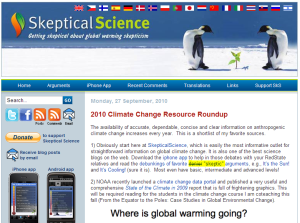 limate reacts is also complex, and it is difficult to separate the effects of natural changes from man-made ones over short periods of time. As the amount of man-made CO2 goes up, temperatures do not rise at the same rate. In fact, although estimates vary the last IPCC report (AR4) described the likely range as between 35.6 and 40.1°Fahrenheit, for double the amount of CO2 compared to pre-industrial levels.
limate reacts is also complex, and it is difficult to separate the effects of natural changes from man-made ones over short periods of time. As the amount of man-made CO2 goes up, temperatures do not rise at the same rate. In fact, although estimates vary the last IPCC report (AR4) described the likely range as between 35.6 and 40.1°Fahrenheit, for double the amount of CO2 compared to pre-industrial levels.
“According to an ongoing temperature analysis conducted by scientists at NASA the average global temperature on Earth has increased by about 1.4°Fahrenheit since 1880. Two-thirds of the warming has occurred since 1975.”
Climate change is happening very quickly compared to changes that occurred in the past: “As the Earth moved out of ice ages over the past million years, the global temperature rose a total of 39.2 to 44.6°Fahrenheit over about 5,000 years. In the past century alone, the temperature climb of 1.4°Fahrenheit is roughly ten times faster than the average rate of ice-age-recovery warming.”
Much has been made of the fact that the rate of surface warming has slowed in the past decade. Yet the physical properties of CO2 and other greenhouse gases cannot change. But if that’s true, where is this heat going? The answer is into the deep oceans.
Before the industrial revolution, the CO2 content in the air remained quite steady for thousands of years. Natural CO2 is not static, however. It is generated by natural processes, and absorbed by others. Natural land and ocean carbon remains roughly in balance and have done so for a long time – and we know this because we can measure historic levels of CO2 in the atmosphere directly in ice cores.
 Although our output of 29 gigatons of CO2 is tiny compared to the 750 gigatons moving through the carbon cycle each year, it adds up when more CO2 is released from outside of the natural carbon cycle by burning fossil fuels because the land and ocean cannot absorb the extra CO2. About 40% of this additional CO2 is absorbed. The rest remains in the atmosphere, and as a consequence, atmospheric CO2 is at its highest level in 15 to 20 million years (Tripati 2009). A natural change of 100ppm normally takes 5,000 to 20,000 years. The recent increase of 100ppm has taken just 120 years).
Although our output of 29 gigatons of CO2 is tiny compared to the 750 gigatons moving through the carbon cycle each year, it adds up when more CO2 is released from outside of the natural carbon cycle by burning fossil fuels because the land and ocean cannot absorb the extra CO2. About 40% of this additional CO2 is absorbed. The rest remains in the atmosphere, and as a consequence, atmospheric CO2 is at its highest level in 15 to 20 million years (Tripati 2009). A natural change of 100ppm normally takes 5,000 to 20,000 years. The recent increase of 100ppm has taken just 120 years).
Human CO2 emissions upset the natural balance of the carbon cycle. Man-made CO2 in the atmosphere has increased by a third since the pre-industrial era, creating an artificial forcing of global temperatures which is warming the planet. While fossil-fuel derived CO2 is a very small component of the global carbon cycle, the extra CO2 is cumulative because the natural carbon exchange cannot absorb all the additional CO2.
The level of atmospheric CO2 is building up, the additional CO2 is being produced by burning fossil fuels, and that build up is accelerating.
Read More
Posted by Michael Haran on Feb 13, 2014
Letter to the Editor
Progressive pedagogy
Santa Rosa Press Democrat
February 10, 2014
EDITOR: Understandably, an official of the Institute of Progressive Education and Learning, Michael Haran, believes that progressive pedagogy should play a strong role in schooling (“The value of common core standards in school,” Close to Home, Thursday). Less clear is why he would insist Common Core should impose progressive pedagogy on all children, despite individual differences that leave some children more in need of structured instruction than others.
Perhaps Haran really believes that governors of the 50 states gathered under the aegis of the National Governors Association and voted for progressive uniformity via Common Core. But that did not happen. The National Governor’s Association’s permanent bureaucracy, the Center for Best Practices, selectively gathered theorists to draft the Common Core curricular guides, drawing on heavy funding from the federal government and the Bill & Melinda Gates Foundation. No record exists of governors voting collectively for Common Core. Indeed, some states neither pay dues to the association nor participate in its proceedings.
Progress in education comes when state and local officials, and especially parents and teachers, are free to exercise choices and implement what is best for each child, as opposed to following a onesizefits-all scheme.
ROBERT HOLLAND
Senior fellow, the Heartland Institute Chicago
Response
Letter to the Editor
2/10/2014
Missing the point
Editor: The letter to the Editor “Progressive pedagogy” (Robert Holland of the conservative think tank the Heartland Institute) totally misses the point of my article but this selective commentary is typical of the far right. It doesn’t matter who initiated the new Common Core Standards the point is that because we have a common culture in the U.S. we need to have a standard education system of core subjects such as math, English, history, technology and science for each K-12 grade. Beyond that each school district is free to include other course such as art, music, P.E., local history and social studies even if it includes creationism and the denial of climate change. Regardless of whether a child goes on to college or not we owe our children a decent education. It’s imperative to each child and it is imperative to American and no 19th century mentality is going to change that.
Michael Haran
Healdsburg
Read More
Posted by Michael Haran on Feb 7, 2014
In this year’s State of the Union speech it sounded like women’s issues are going to be a big part of the Democratic 2014 campaign strategy. In 2013 we saw an unprecedented number of women in the U.S. Senate and a lot has been written about the assentation of women. Sheryl Sandberg’s book, “Lean In: Women, Work, and the Will to Lead” has described the evolution of the modern American women and the roll they must play to get ahead in the corporate boardroom.
During WWII women had good jobs. They were contributing to the war effort and had a high self-worth. After the war many of their jobs were eliminated and the jobs created by the post-war economic boom were filled by the men returning from the war. Millions of women had no choice but to become stay-at-home mothers or house wives. Now that in its self is not bad. Given the option many women would choose that life style in a heartbeat but that’s the point – it’s about options. 
When I was growing up I felt a frustration in the women that were raising me. My mother was fear based and there was little joy in the Catholic nuns that taught me. At a young age I thought that that was just the way things were and then along came the Cultural Revolution of the 1960s and with it the sexual revolution of the American women. Women wanted to be able to have sex like a man but soon realized that that wasn’t in their best interest and human nature soon reasserted itself. But what did come from it was the beginning of the liberation of the American women which is still going on.
What many people don’t recognize is that the equality of women is just as important to men as it is to women. Women are born multitaskers. They had to be because of the uncertainties of raising a child not knowing whether the father was going to be around. The four Cs that we are trying to instill in our K-12 student for the most part come natural to women. Women have for years used collaboration, critical thinking, cooperation and creativity to survive in a male dominated world. A single mother who has to work while raising a child needs a very exact skill set to not only to function but also to put the child’s development first. Evolution has given women a natural tenancy to run things driven by this subconscious, or conscious, desire for survival. Any man who has cohabitated with a woman knows who runs the household.
Not long ago I was talking with a young Saudi man who was raised in London. We were talking about the station of women in Saudi Arabia particularly about the right to drive a car. I will never forget his remark about why women should be treated as equals in any society. “Women get it in a way men don’t” he said. That just about sums it up.
When a young couple gets married and has a child it’s the mother who is first up to bat. Nature has equipped the mother both physically and emotionally to be the infant’s primary care giver. As the child grows the mother and father both share care for the toddler and around five years old either parent can participate in the child’s activities.
Now let’s say that the mother is career oriented and the father would rather earn a living working from home in say woodwork or writing but he can’t quit his job because the wife can’t earn as much as he can. If women were completely equal in the work place this would not be a problem. Society would benefit, the economy would benefit and the family would benefit.
The bottom line is equality would allow women to not only do what they do best but also get paid for it. Equality is good for everyone.
Read More



























